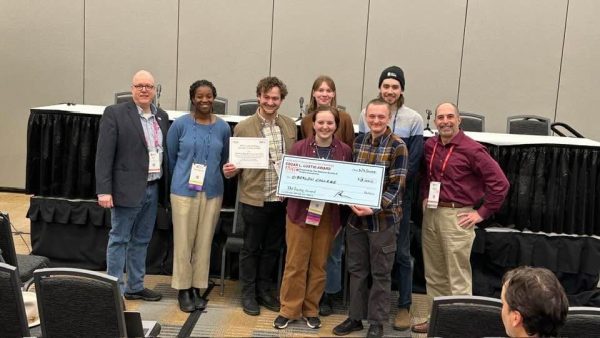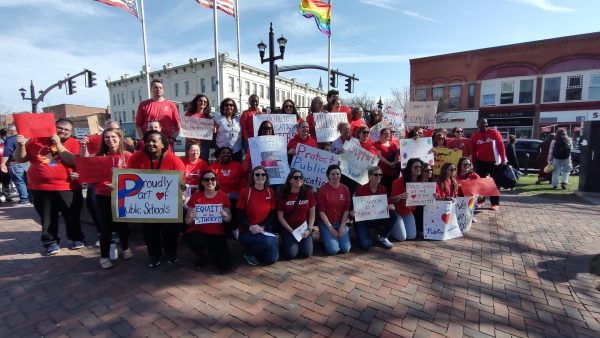Campus Housing Announcements Spark Student Confusion, Frustration
Students remaining in College-owned housing were left confused and frustrated last week after receiving a pair of email communications — the first from the Office of Residential Education and the second from President Carmen Twillie Ambar — regarding potential changes to their living situations. The emails came after most students were required to vacate campus housing last month in response to the COVID-19 pandemic; students who stayed on campus went through a petition process in order to do so.
On Tuesday, April 7, ResEd informed students in campus housing that they should start packing up their belongings in order to be “consolidated” into South, Langston, or Noah Halls beginning Friday, April 17. The roughly 160-word announcement cited energy and resource consumption as the primary reason for the consolidation. Then, on Friday, April 10, President Ambar put the brakes on, saying that a decision about on-campus housing had been “delayed.”
“We made a misstep during a recent communication announcing housing changes impacting the 250 students who remain on campus,” President Ambar’s email read. “A number of you reached out to me to express concern that these changes would endanger students and introduce additional stress at a time when we all are trying to focus on academic and musical pursuits.”
Students were active in voicing their displeasure at the decision as soon as it was announced, circulating a petition that garnered nearly 500 signatures from students and alumni. The petition listed 10 reasons why the undersigned opposed the consolidation decision, and provided five alternative proposals. A primary concern was that students would be unable to observe safe social distancing practices — especially in shared kitchens and bathrooms — if consolidated into just three buildings. Currently, students are spread out all over campus; according to Vice President and Dean of Students Meredith Raimondo, the only dorm that is completely unoccupied is Dascomb Hall.
The petition also referenced the original email from ResEd, the framing of which many students objected to, including College third-year Julia Rohde.
“I have such a lack of faith in this administration and its concern for our wellbeing, for a lot of reasons,” said Rohde, who currently lives in a Firelands Apartment with an individual kitchen and bathroom. “That email to me implied that saving money and resources for the College took precedence over my own health and the health of other students, who are all on campus because they’re a vulnerable population for whatever reason.”
Raimondo apologized to students for the original email’s tone.
“That was really an error, for which I take personal responsibility” Raimondo said. “I think we were doing too many things too quickly and didn’t fully review the communication before it went out to make sure it fully explained the health and safety rationale and planning. I certainly apologize to anyone for whom it caused undue stress. That was never the intention.”
Rohde, along with all other students remaining in College-owned housing, were initially permitted to stay after submitting a petition in March. According to Raimondo, the Division of Student Life created parameters for which petitions were accepted.
“We gave permission to remain on campus to F-1 visa-holders, to students who would be homeless without their Oberlin housing, or to students who would be unsafe without their Oberlin housing,” Raimondo said.
Financial need was not, on its own, enough for a student to be granted a spot on campus. Raimondo added that the College did provide financial assistance to students for whom the cost of a last-minute plane ticket, for example, would be prohibitive.
“We were able to help them buy a plane ticket and get them to where they were going,” Raimondo said. “It depended on the individual circumstances, whether a solution that would allow them to leave campus was possible.”
College-owned housing was emptied of students without approved petitions by noon on Monday, March 16. From there, staff in the Division of Student Life began conversations about how to house the remaining students on campus, and what to do with the belongings that many other students had to leave behind in their vacated living spaces.
Students remaining on campus have reported seeing College employees consolidating belongings from some dorm rooms into others. Raimondo said that this process has not yet been fully finalized.
“The plan right now is to continue to try and get the buildings ready,” Raimondo said. “In some cases, some things have been moved out [from unoccupied rooms] in anticipation that you would want to use those rooms for COVID-19 isolation spaces. The College is going to safely store those belongings. Obviously some people will not be returning to campus, like graduating seniors, and so we’re going to have to figure out how to reunite those folks with their belongings. We don’t have the details of that worked out yet.”
According to Dave Covell, Lorain County public health commissioner, the original consolidation decision was made in consultation with his office in preparation for two potential outcomes: first, that local public health authorities would need to use the College’s apartment-style housing to quarantine individuals who have contracted or been exposed to COVID-19 and, second, so that local health care workers could choose to stay in the College’s dorms rather than return home and risk exposing their families.
Covell maintained that, in his view, it’s possible to achieve safe social distancing practices in dorms, even with shared bathrooms and kitchens. Still, he added that, in an ideal world, all students would have access to private bathrooms and kitchens.
“It’s important to remember that in a normal dorm setting [you] have two people in a room and multiple people on a floor,” Covell said. “But if you can go down to a single person in each room and fewer people on each floor, you can actually still achieve the social distancing they need.”
Hearing about the potential use of College-owned living spaces for public health purposes — which had not been mentioned in ResEd’s email — did somewhat shift Rohde’s perspective on the consolidation decision.
“Once I heard these rumors about health care care providers, I was like, ‘Okay, this makes more sense because that’s a more vulnerable population than the student body at the moment,’” Rohde said. “But at the same time, I’m still confused how that necessitates people in Firelands or Village Housing all moving out because it does seem like the College has the capacity to offer support for these health care workers without totally disrupting everyone else’s living situation at the moment.”
Rohde mentioned specific logistical challenges with a potential move, such as moving furniture and kitchen appliances intended for use in an apartment into a single dorm room. Moving groceries from a personal refrigerator would present challenges as well.
Covell said that, as of last week, it was not totally clear how many beds and apartments the county will end up needing for public health uses.
“It’s important to remember [that], for every case, we average about three or four people that get quarantined,” Covell said. “If we all of a sudden have a surge in cases, we will have a decent amount [of people who need to be housed].”
Covell added that his office is working with other organizations in the area to maintain available living spaces, including several local hotels. For now, the plan is still for potentially infected people to self-quarantine in their homes whenever possible. On Monday, three days after President Ambar’s email, the College was informed that local public health authorities no longer anticipate that they will need to make use of College-owned living spaces given the progress with containing the statewide outbreak, according to Raimondo.
“Knowing that it is not now allows us to do a different kind of planning,” Raimondo wrote in a follow-up message to the Review. “This information was not known when the relocation email was sent.”
Currently, the COVID-19 outlook in Ohio is generally positive, relative to other states. Data compiled by the Institute for Health Metric and Evaluation at the University of Washington indicates that statewide resource use needed to combat the outbreak will peak this week, after which point the number of hospital beds needed daily will decrease. At no point is Ohio projected to face a shortage in bed capacity. Still, public health officials stress that constant vigilance is required.
Raimondo said that another consideration behind the initial consolidation announcement was employee health.
“The other major reason is the strain on employees and our need to protect employee health,” Raimondo said. “There are certainly some essential employees who would prefer not to report to campus, but to maintain minimum staffing levels to service the full residential footprint requires a lot of people.”
As of now, the housing status of students remaining on campus has not been finalized. Raimondo said that the next steps will be taken in coordination with faculty governance bodies and students remaining on campus.
“I hope that those conversations will help us arrive at the best decision,” Raimondo said. “I wouldn’t want to predict what that is, to make sure that I honor the good faith intention of going into those conversations with an open mind and not a fixed outcome.”
In response to President Ambar’s decision to walk back the initial consolidation, students published a public thank-you letter to the students, faculty, and community members who advocated on their behalf.
“Last but not least, we want to thank all the students, alumni, and parents who offered all the help within their power,” the letter read. “While the pandemic changed our lives a lot, we know we are always bonded. Although we can’t talk to each other face to face, we worry about each other like family members. Thank you for sharing your warmth, like family.”





